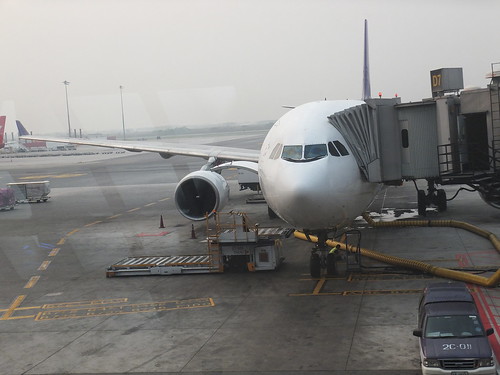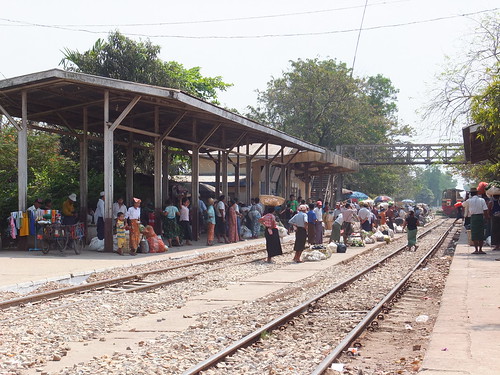Events of Thursday 21st February 2013
At 8.0 a.m. I was collected by a charming young lady guide from Yangon called Miss Khin Khin Chaw with a driver and Toyota 'Hiace'. They'd driven from Yangon to Mandalay the previous day to meet me. That journey takes over 8 hours. On the Thursday, we were only going as far as Napyidaw (about 5 hours driving) and we would overnight there. The highway from Yangon to Mandalay has only been open a few years. It's dual carriageway with at least two lanes each way and broad verges (except where the highway passes over bridges). The road's most impressive feature is how little traffic there is.
The uncrowded highway from Mandalay to Napyidaw.
I'd planned to visit Paleik station on the double-track main line from Mandalay to Yangon and so we turned off the highway and were immediately on country roads where the tarmac strip is only wide enough for one vehicle so that passing vehicles each have to drive with one wheel on the verge. We passed through a village with simple bamboo houses very similar to the one I visited in Nga-Minn-May a few days earlier.
Rural life on the way to Paleik.
Leaving the village, we were plunged back into open country. Just as I was starting to despair, we came to a small town and found the station. I gathered what information I could and we waited while a mixed train from Mandalay passed without stopping.
A southbound train passes through Paleik.
Our driver retraced our route to get back to the highway and we continued south. We carried on to the 'Rest Stop' about halfway to Napyidaw. This had a large cafe area and I realised it was designed to handle the sudden influx of people when a number of long-distance buses stopped.
The Rest Stop en route to Napyidaw.
We carried on to the junction for Napyidaw and joined a short length of highway which passed a Toll Station and then led us through a residential zone of Napyidaw. The main roads were all dual carriageway, with at least four lanes in each direction but traffic was very sparse. Electric lighting was provided and all the verges were planted with trees and shrubs and well-tended.
Napyidaw: Four lanes each way, but little traffic.
New building was going on around us, particularly as we passed through the Hotel Zone (Napyidaw is a 'planned' new city built on a 'greenfield' location). My guide asked if I'd like to check into my hotel but I was anxious that we located the Railway Museum. Although my guide and driver seemed convinced there was such a museum, they didn't know where it was (it was my guide's first visit to the capital). I suggested enquiring at the main railway station, but they preferred to ask the groups of people relaxing on the verge near each road junction. This was not productive.
By then, we were driving through the government office area - the road we were on merely carried signs to the various ministries and landscaped side roads led to the actual buildings. There was a certain irony that the Ministry of Information had no idea about a railway museum but a second attempt at the Ministry of Rail Transportation apparently obtained some guidance. I was quite taken by a rather odd 3-aspect upper quadrant semaphore signal at the road junction and even more taken with the plinthed locomotive (a class 'ST' 2-6-4T) near the offices.
Class 'ST' 2-6-4T displayed at the Ministry of Rail Transportation.
The locomotive appeared to be festooned in chains of 'fairy lights' outlining the shape so I probably wouldn't have been quite so impressed if I'd seen it at night. The actual ministry building was a modest, modern office block - I'd expected something more flamboyant.
Leaving the Ministry, I knew our route was now taking us towards the railway line, so I was a little more hopeful. Once the double-track line was in sight, I spotted a semaphore distant signal which enabled me to confirm the direction to the nearest station. Unfortunately, my guide and driver were convinced that our route lay in the opposite direction. It was only after a mile or so of increasingly rural travel that they could be persuaded to turn around and retrace our steps. I was much happier as we approached a station but couldn't help pointing out that it seemed a very small, very rural station to host a museum. However, I was always happy to do a quick survey of another station so we crossed the tracks to the station buildings at Twa Daw, where my guide was assured by the stationmaster that the museum was located at the next station along - the main railway station for Napyidaw.
After another drive along the wide, virtually deserted roads we came to the huge, modern station of Napyidaw. The station and its ten platforms were certainly impressive but it was odd that there were no other buildings nearby, no sign of the city it served. It reminded me a little of all the 'Parkway' stations we now have in England, where the name is a warning that the place served is some distance away. It was also odd that, in the whole time we spent in the vicinity of the station, not a single wheel turned on the railway. There were coaches, diesel locomotives and railcars but all with an abandoned air, in stark contrast to the permanent bustle around Yangon Central station.
Napyidaw Station.
The guide enquired as to the exact location of the museum - it was another modern building about 100 yards from the station. Yes! It was clearly marked 'Myanma Railway Museum' and 'Inaugurated 4th January 2012'. It was also clearly closed.
Thwarted by a decorative security gate and padlock.
It was here that my guide showed her true colours. Bidding me wait, she and the driver disappeared towards the station. I reviewed what was outside. A wooden shelter housed a short length of track mounting a wagon wheelset and a coupled wheelset. Nearby there were three wheelsets with a ''cowcatcher' and chopper coupling mounted on an curious undulating length of 'track'. I could only assume this was 'Art' because, even in my rather jaundiced state of mind, I had to admit that this 'track' was worse than any of the permanent way I'd seen in Burma (and I'd seen some very poor track).
Burmese Art (?) with the rather grand museum building in the background.
A little way off, there was an example of topiary in the general shape of a locomotive. I decided it was a bit too hot to look at this just then. Further off, there was a plinthed locomotive which definitely deserved inspection, but I decided to keep this as my 'consolation prize' for failing to visit the museum. At that moment, my guide and driver returned with three people in tow. One was apparently the curator, and one had a key for the padlock. Success! There was quite a reasonable display of models and fairly small artefacts. Most had simple descriptions in English I spent around 40 minutes furiously trying to capture as much as possible for further study.
Then it was check on the topiary, record the rather handsome plinthed 'Pacific (not sure about the chimney extension, though) and I rejoined the car, totally exhausted, with a view to finding the hotel.
The plinthed, oil-burning 'Pacific' outside Napyidaw station.
Before we drove off, my guide innocently enquired "Don't you want to look at that?". I'd completely missed what's supposed to be the first steam locomotive in Burma - a 'Dubs' 2-4-0 tank with an odd smokebox extension displayed inside the main station building.
Locomotive A.01 - a 2-4-0T built by Dubs & Co. in Glasgow, put into service 1-May-1877. Weight: 17.65 tons. Tractive Effort: 3857 lbs.
Finally, having snatched a few pictures of the Dubs, we set off to find my hotel - the Aureum Palace Hotel. Having booked in at Reception, I was taken in an electric golf cart about 200 yards to a very decent semi-detached 'villa' overlooking an artificial, but attractive small lake. The lake had a fair population of geese.
My semidetached 'villa' at the Aureum Palace Hotel.
I wasn't quite finished for the day, because my guide had offered to return and take me to see the modern golden pagoda in Napyidaw and I'd agreed to be ready to go out again in a couple of hours.
My Pictures
Road from Mandalay to Napyidaw.
Paleik Station.
Around Napyidaw.
Twa Daw Station.
Napyidaw Station.
Myanma Railway Museum.
Aureum Palace Hotel, Naypyitaw.
[Revised 8th March 2013, 17-Mar-2013, 19-Mar-2013, 20-Mar-2013]




